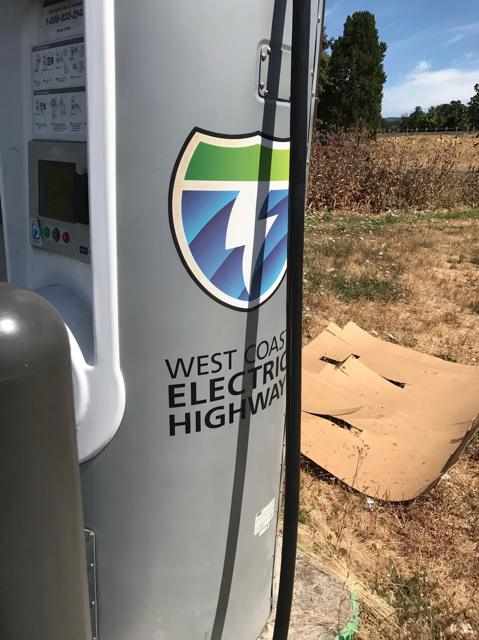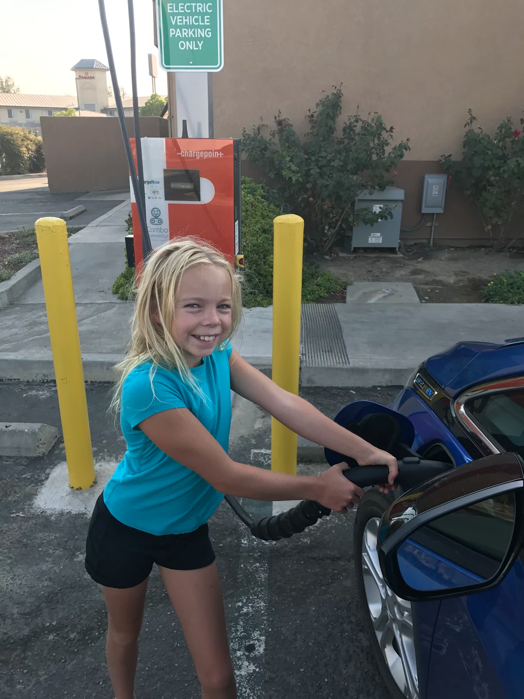Part I
I wanted to travel with my daughter Rosie before she started her next journey in middle school. A daddy-daughter road trip before new interests would arrive in her life.
It just so happened that the week we planned to travel together was the week of the total eclipse. And I decided we should travel gas-free in our 100% electric, battery-powered Chevy Bolt. It would be an all-American electric eclipse. You know -- baseball, hot dogs, apple pie, and Chevrolet.
It’s our second EV (the first a Fiat 500e), both made affordable as leases and with California’s EV rebate program (we pay about $300/month, with nothing down after rebates, and little to no maintenance costs, no oil changes, often free public charging around town, etc.). We’d chosen Evs to reduce our carbon footprint and be part of the climate solution, and quickly discovered how fun they are to drive, with their super fast acceleration from a starting point (or torque).
I’d traveled to the Bay area from our South Lake Tahoe home in our electric vehicle (EV) before, but not further. That corridor is chock full of charging stations, but I didn’t know what we’d find in the great wide open.
We’d thought about a trip to Yellowstone, with an eclipse party along the route at a friend’s place in Idaho. But the Chargepoint EV charging station app showed some big gaps along that route – especially in eastern Nevada, and large stretches of Idaho.
I looked into portable charge cords – and almost visited the nearby Clipper Creek plant in Auburn, CA to pick one up. Then we could have stayed in RV parks and plugged in overnight, or along the way if need be, and would have been able to mitigate “range anxiety”, otherwise known as the fear of using up your battery life before you reach your destination. But I decided we should make it even more of an adventure (and save money) by relying only on public charging stations along the way.
We pulled out the atlas– yes the paper kind, remember those? Using the Chargepoint EV charging station app as a reference, Rosie used different highlighters to color code each type of station along our prospective routes. Yellow for Level 2, 220 Volt chargers that provide 25-30 miles of driving range per hour of charge; Green for Direct Current (DC) fast chargers with the type of “combined charging system” (combo) plugs needed for our Bolt, that offer 60-180 miles/hour depending on the power supply of the charger.

A charging station along the West Coast Electric Highway.
This exercise soon had us choosing the Interstate 5 corridor to catch the eclipse in Oregon, where I’d just learned that my singer-songwriter friend Keith Greeninger was playing an “Eclipse of the Garden” concert in in the Oregon Gardens in Silverton, just east of Salem. Turns out that CA, OR and WA collaborated on creating a West Coast Electric Highway, an “extensive network of electric vehicle (EV) DC fast charging stations located every 25 to 50 miles along Interstate 5 and other major roadways in the Pacific Northwest.” Perfect for us.
We packed the car and set off on the Saturday afternoon before the Monday eclipse (after Rosie’s gymnastics team class), with our 5-seat Bolt packed with tent, camp chairs, ukuleles, guitar, books, sleeping bags, and camp food. The Bolt has a surprising amount of storage capacity. We didn’t have any reservations, because I wasn’t sure how far we’d get, and wanted to keep it open.

Our first charge in Williams, CA.
Our first charge stop was Williams, CA. The Chargepoint “quick charger” there is located in front of a Carl’s Jr restaurant, which is an unexpected pairing. Rosie plugged the charger in, as she’d do at each of our 14 charging stops on our trip. We left the car charging for an hour and 45 minutes, while we bypassed Carl’s Double Western Bacon Cheeseburgers for a family owned Mexican restaurant nearby. The tostada was delicioso. We topped that off with an ice cream cone next door, while playing a few hands of spades.
Our bill for the charge was $11.61, which added an estimated 114 miles of capacity to our battery from the 24Kw sort-of-fast charge station (RPH of 63 miles). We paid 10 cents/mile for the charge, approximately the same we would have paid for $3/gallon gas at 30 mpg. Saving a little money and a lot of pollution. We would leave nothing in the air behind our emission-free car, and given California’s mix of electricity sources, 80% fewer emissions all things considered, from “well to wheel.” In Oregon, with its large share of emissions-free hydropower to generate electricity, the emissions associated with powering our car would be only 13% of a conventional, internal combustion engine.
This is part one in a four part series. Check back daily for parts two, three and four.
This was blog was posted during National Drive Electric Week (NDEW). From September 9-17, 2017, come take part in a nationwide celebration to heighten awareness of today's widespread availability of plug-in vehicles and highlight the benefits of all-electric and plug-in hybrid-electric cars, trucks, motorcycles, and more. Are you considering going electric like John? Come talk to owners who have successfully done so at an NDEW event near you.